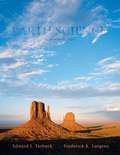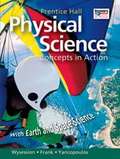- Table View
- List View
Prentice Hall Earth Science
by Charles R. Coble Dale Rice Kenneth J. Walla Elaine G. MurrayEarth scientists study the earth and its characteristics. They investigate the far reaches of space, the depths of the oceans, and the interior of the earth.
Prentice Hall Earth Science (11th edition)
by Edward J. Tarbuck Frederick K. Lutgens Dennis TasaThe latest edition of a broad and nonquantitative survey at the introductory level of topics in geology, oceanography, meteorology, and astronomy.
Prentice Hall Earth Science: Physical Setting/Earth Science, New York
by Edward J. Tarbuck Frederick K. Lutgens Dennis TasaNIMAC-sourced textbook
Prentice Hall Earth's Changing Surface
by Michael J. Padilla Martha Cyr Loannis MiaoulisThe authors have developed a program that meets the needs of middle grades students, promotes science inquiry, and is aligned with the National Science Education Standards.
Prentice Hall Explorador De Ciencias (Grado 6, Texas Edicion)
by Steve Miller Joseph D. Exline Jay M. Pasachoff Jan Jenner Carole Garbuny Vogel Fred Holtzclaw Elizabeth Coolidge-Stolz Donald Cronkite David V. Frank Linda Cronin-Jones Barbara Brooks SimmonsA Spanish Science textbook.
Prentice Hall Exploring Earth Science
by Susan Johnson Jean Hopkins David Lahart Maryanna Quon Warner Jill D. Wright Anthea MatonIf you think about it, you will quickly realize that there are many things you might question and seek answers to. Put another way, the universe is really a collection of countless mysteries. It is the job of scientists to solve those mysteries. The goal of science is to understand the world around us.
Prentice Hall Exploring Earth Science
by Prentice HallThroughout your study of science, you will learn a variety of terms, facts, figures, and concepts. Each new topic you encounter will provide its own collection of words and ideas--which, at times, you may think seem endless.
Prentice Hall Exploring Earth's Weather
by Susan Johnson Jean Hopkins David Lahart Maryanna Quon Warner Jill D. Wright Anthea MatonThroughout this book one will learn a variety of terms, facts, figures, and concepts in relation to science.
Prentice Hall Exploring Life Science
by Susan Johnson Jean Hopkins Maryanna Quon Warner Jill D. Wright Anthea MatonLife science textbook.
Prentice Hall Exploring Life Science
by Prentice HallThroughout your study of science, you will learn a variety of terms, facts, figures, and concepts. Each new topic you encounter will provide its own collection of words and ideas--which, at times, you may think seem endless. But each of the ideas within a particular topic is related in some way to the others. No concept in science is isolated. Thus it will help you to understand the topic if you see the whole picture; that is, the interconnectedness of all the individual terms and ideas. This is a much more effective and satisfying way of learning than memorizing separate facts.
Prentice Hall Exploring Physical Science
by Susan Johnson Jean Hopkins David Lahart Maryanna Quon Warner Jill D. WrightThe universe around you and inside of you is really a collection of countless mysteries. It is the job of scientists to solve those mysteries. The goal of science is to understand the world around us. How do scientists go about understanding the world? Like all good detectives, scientists use special methods to determine truths about nature. Such truths are called facts. Here is an example of a fact: The sun is a source of light and heat. But science is more than a list of facts--just as studying science is more than memorizing facts. Jules Henri Poincaré, a famous nineteenth-century French scientist who charted the motions of planets, put it this way: "Science is built up with facts, as a house is with stones. But a collection of facts is no more a science than a heap of stones is a house." So scientists go further than simply discovering facts. Scientists try to use facts to solve larger mysteries of nature. In this sense, you might think of facts as clues to scientific mysteries. An example of a larger mystery is how the sun produces the heat and light it showers upon the Earth. Another larger mystery is how the relatively few and simple organisms of 3 billion years ago gave rise to the many complex organisms that inhabit the Earth today. Using facts they have gathered, scientists propose explanations for the events they observe. Then they perform experiments to test their explanations. In the next section of this chapter, you will learn how scientists go about performing experiments and uncovering the mysteries of nature.
Prentice Hall Life Science
by Jan Jenner Marylin Lisowski Linda Cronin Jones Elizabeth Coolidge-Stolz Donald CronkiteThe "Prentice Hall Life Science" edition contains topics on Cells and Heredity, Diversity of Living Things, Human Biology and Health and Ecology. Added attraction of the book is Reference Section, Skills Handbook, Activities, Labs, At-Home Activity, etc.
Prentice Hall Life Science (2nd edition)
by Prentice HallThis book comprises seven units of twenty five chapters and the contents include Characteristics of Living Things, Simple Organisms, Plants, Animals, Human Biology, Heredity and Adaptation, and Ecology.
Prentice Hall Physical Science Concepts in Action
by Prentice HallThe academic standards for physical science outline the scientific inquiry skills and core content for all physical science classes in South Carolina schools. Each standard specifies a particular range of science topics. Following each standard is a set of indicators that state the thought processes, content knowledge, and skills that students must demonstrate in order to meet the standard. Your physical science course is designed to provide you with a conceptual understanding of the world around you. The Science Academic Standards provide a basic structure for your physical science course by specifying important content areas and process skills. The knowledge gained from your physical science course will serve as the foundation for your other high school science courses. At the end of your physical science course, you will take the state-required end-of- course examination. The end-of-course examination tests your knowledge of the academic standards for physical science. Using this book will help you master the physical science standards in preparation for the end-of-course examination.
Prentice Hall Physical Science Concepts in Action, with Earth and Space Science
by Michael Wysession David Frank Sophia YancopoulosNIMAC-sourced textbook
Prentice Hall Physical Science: Concepts in Action
by Michael Wysession David Frank Sophia YancopoulosNIMAC-sourced textbook
Prentice Hall Physical Science: Concepts in Action
by Michael Wysession David Frank Sophia YancopoulosPrentice Hall Physical Science: Concepts in Action enables students connect to the science they experience everyday and the one they are taught in class.
Prentice Hall Physical Science: Concepts in Action, Georgia
by Michael Wysession David Frank Sophia YancopoulosNIMAC-sourced textbook
Prentice Hall Science Explorer (Grade 6, New Mexico Edition)
by Prentice HallThis edition contains unit lessons on Exploring Planet Earth, Earth's Changing Surface, Earth's Waters, Weather and Climate and Astronomy. Reference Section and Skills Handbook are additional features.
Prentice Hall Science Explorer (Texas, Grade #6)
by Michael J. Padilla Ioannis Miaoulis Martha CyrThis volume of Texas Essential Knowledge and Skills for Science comprises four units and the contents of which include Properties of Physical Systems, Structure and Function in Living Systems, Matter and Energy in the Environment, Earth and Space Systems--Structure and Function and Reference Section.
Prentice Hall Science Explorer (Texas, Grade #7)
by Prentice HallThe state of Texas has established standards describing science knowledge and skills for which students are responsible. These standards are known as the Texas Essential Knowledge and Skills, or TEKS. State assessments of student achievement in science are based on these TEKS. The Grade 7 TEKS are listed below. The chapter references show where the content and skills are addressed in this textbook. An individual TEKS may be addressed in more than one chapter. Some chapters address only a part of a TEKS.
Prentice Hall Science Explorer (Texas, Grade #8)
by Prentice HallEducational material on exploring Science which include Physical Systems-- Matter and Energy, Light and the Universe, Earth Systems, Human Activities and Earth Systems, Human Activities and Earth Systems, Genetics and Interdependence Among Living Systems and also a Reference Section.
Prentice Hall Science Explorer Astronomy
by Michael J. Padilla Ioannis Miaoulis Martha CyrNIMAC-sourced textbook
Prentice Hall Science Explorer Astronomy
by Michael J. Padilla Ioannis Miaoulis Martha CyrThe ancient Egyptians were among the first people to study the stars. The study of the moon, stars and other objects in space is called astronomy. Ancient astronomers also studied the movements of the sun and the moon as they appeared to travel across the sky. It seemed to them as though Earth were standing still and the sun and moon were moving. Actually, the sun and moon seem to move across the sky each day mainly because Earth is rotating on its axis.
Prentice Hall Science Explorer Cells and Heredity
by Michael J. Padilla Ioannis Miaoulis Martha CyrA majestic oak tree shades you on a sunny day at the park. A lumbering rhinoceros wanders over to look at you at the zoo. After a rain storm, mushroom sprout in the damp woods. What do think an oak tree, a rhinoceros, and a mushroom have in common? You might say that they are all living things. What makes these living things--and all other living things--alike? If you say they are made of cell, you are correct.


